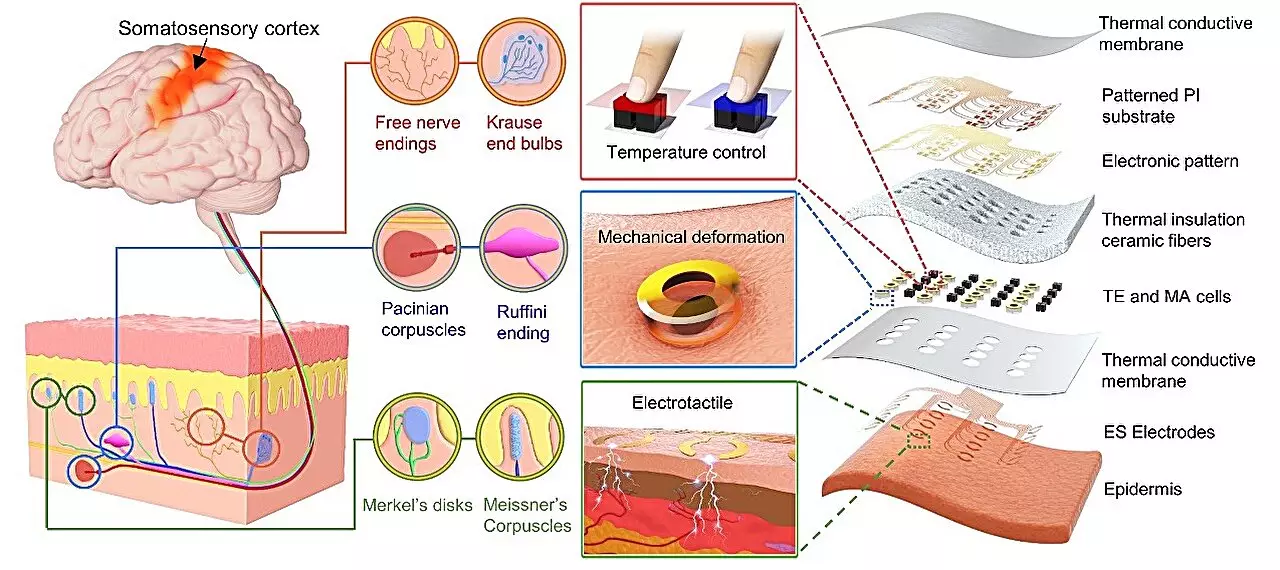Virtual reality (VR) and augmented reality (AR) have revolutionized the way we experience digital media, providing immersive and engaging environments. However, there is still much room for improvement, particularly in terms of stimulating other senses beyond vision and hearing. Researchers at the City University of Hong Kong and other Chinese institutes are pushing the boundaries of haptic interfaces, aiming to connect users with virtual environments through a sense of touch. In a recent study published in Nature Electronics, they introduced a groundbreaking haptic interface that delivers multi-dimensional tactile signals directly on the skin, creating realistic sensations that can enhance virtual experiences to a whole new level.
Currently, the majority of research on flexible electronics focuses on the development of sensors, with limited investigation into feedback techniques. Recognizing this gap, Professor Xinge Yu from the City University of Hong Kong and Hong Kong Science Park spearheaded the integration of flexible mechanical feedback actuators into flexible electronic technology, resulting in significant advancements for various fields, including social media, gaming, control and feedback of prosthetics, and biomedical applications.
Building upon previous work, Professor Yu’s research group introduced a wireless electrostimulation haptic interface that addressed the challenge of creating diverse immersive tactile sensations in a recent paper published in Nature Machine Intelligence. By selectively stimulating different receptors, the interface is capable of reproducing tactile sensations that correspond to various textures, facilitating a more realistic and interactive experience.
The human body is capable of perceiving a wide range of tactile information when encountering objects or surfaces. This is made possible by biological mechanisms that process various types of tactile feedback. To maximize the effective reproduction of human touch sensation in VR and AR, the researchers incorporated three feedback modes into a single skin-integrated interface. This breakthrough offers a significant advantage, enabling highly realistic touch experiences by delivering multi-dimensional tactile signals.
Current haptic feedback technologies are divided into two primary directions: electrical stimulation and mechanical actuation. Electrical stimulation faces the challenge of accurately activating nerves to generate authentic tactile sensations within the human body. On the other hand, mechanical actuation replicates the skin’s surface deformation when interacting with physical objects. Huang and his colleagues successfully combined the advantages of both approaches, achieving diverse and immersive tactile feedback effects. By integrating multiple feedback modes within a single device, they have paved the way for new possibilities in providing users with richer and more realistic touch experiences.
The breakthrough skin-integrated multimodal haptic interface developed by Huang and his team is a significant contribution to the field of haptic technology. It has the potential to open up new possibilities for highly immersive VR content accompanied by realistic tactile sensations. However, there is still room for development in the field of haptic feedback. Further research in material synthesis, mechanical structure optimization, and neuro electrophysiology will be essential in refining the design principles and fabrication of haptic interfaces.
The advancement of haptic interfaces for virtual reality and augmented reality brings us one step closer to creating truly immersive and realistic digital experiences. The innovative research conducted by Professor Xinge Yu and his team at the City University of Hong Kong lays the foundation for future advancements in haptic feedback technology. By bridging the gap between electrical stimulation and mechanical actuation, they have unlocked new possibilities for delivering multi-dimensional tactile sensations. As technology continues to evolve, we can expect virtual experiences to become increasingly indistinguishable from reality, engaging and captivating our senses in ways we’ve never imagined before.


Leave a Reply